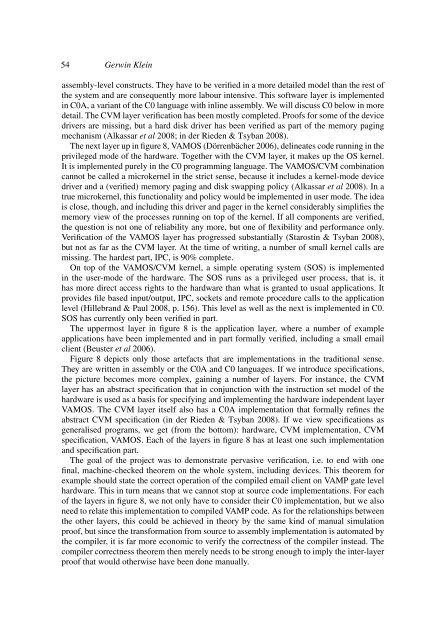Operating system verificationâAn overview
Operating system verificationâAn overview
Operating system verificationâAn overview
Create successful ePaper yourself
Turn your PDF publications into a flip-book with our unique Google optimized e-Paper software.
54 Gerwin Klein<br />
assembly-level constructs. They have to be verified in a more detailed model than the rest of<br />
the <strong>system</strong> and are consequently more labour intensive. This software layer is implemented<br />
in C0A, a variant of the C0 language with inline assembly. We will discuss C0 below in more<br />
detail. The CVM layer verification has been mostly completed. Proofs for some of the device<br />
drivers are missing, but a hard disk driver has been verified as part of the memory paging<br />
mechanism (Alkassar et al 2008; in der Rieden & Tsyban 2008).<br />
The next layer up in figure 8, VAMOS (Dörrenbächer 2006), delineates code running in the<br />
privileged mode of the hardware. Together with the CVM layer, it makes up the OS kernel.<br />
It is implemented purely in the C0 programming language. The VAMOS/CVM combination<br />
cannot be called a microkernel in the strict sense, because it includes a kernel-mode device<br />
driver and a (verified) memory paging and disk swapping policy (Alkassar et al 2008). In a<br />
true microkernel, this functionality and policy would be implemented in user mode. The idea<br />
is close, though, and including this driver and pager in the kernel considerably simplifies the<br />
memory view of the processes running on top of the kernel. If all components are verified,<br />
the question is not one of reliability any more, but one of flexibility and performance only.<br />
Verification of the VAMOS layer has progressed substantially (Starostin & Tsyban 2008),<br />
but not as far as the CVM layer. At the time of writing, a number of small kernel calls are<br />
missing. The hardest part, IPC, is 90% complete.<br />
On top of the VAMOS/CVM kernel, a simple operating <strong>system</strong> (SOS) is implemented<br />
in the user-mode of the hardware. The SOS runs as a privileged user process, that is, it<br />
has more direct access rights to the hardware than what is granted to usual applications. It<br />
provides file based input/output, IPC, sockets and remote procedure calls to the application<br />
level (Hillebrand & Paul 2008, p. 156). This level as well as the next is implemented in C0.<br />
SOS has currently only been verified in part.<br />
The uppermost layer in figure 8 is the application layer, where a number of example<br />
applications have been implemented and in part formally verified, including a small email<br />
client (Beuster et al 2006).<br />
Figure 8 depicts only those artefacts that are implementations in the traditional sense.<br />
They are written in assembly or the C0A and C0 languages. If we introduce specifications,<br />
the picture becomes more complex, gaining a number of layers. For instance, the CVM<br />
layer has an abstract specification that in conjunction with the instruction set model of the<br />
hardware is used as a basis for specifying and implementing the hardware independent layer<br />
VAMOS. The CVM layer itself also has a C0A implementation that formally refines the<br />
abstract CVM specification (in der Rieden & Tsyban 2008). If we view specifications as<br />
generalised programs, we get (from the bottom): hardware, CVM implementation, CVM<br />
specification, VAMOS. Each of the layers in figure 8 has at least one such implementation<br />
and specification part.<br />
The goal of the project was to demonstrate pervasive verification, i.e. to end with one<br />
final, machine-checked theorem on the whole <strong>system</strong>, including devices. This theorem for<br />
example should state the correct operation of the compiled email client on VAMP gate level<br />
hardware. This in turn means that we cannot stop at source code implementations. For each<br />
of the layers in figure 8, we not only have to consider their C0 implementation, but we also<br />
need to relate this implementation to compiled VAMP code. As for the relationships between<br />
the other layers, this could be achieved in theory by the same kind of manual simulation<br />
proof, but since the transformation from source to assembly implementation is automated by<br />
the compiler, it is far more economic to verify the correctness of the compiler instead. The<br />
compiler correctness theorem then merely needs to be strong enough to imply the inter-layer<br />
proof that would otherwise have been done manually.
















